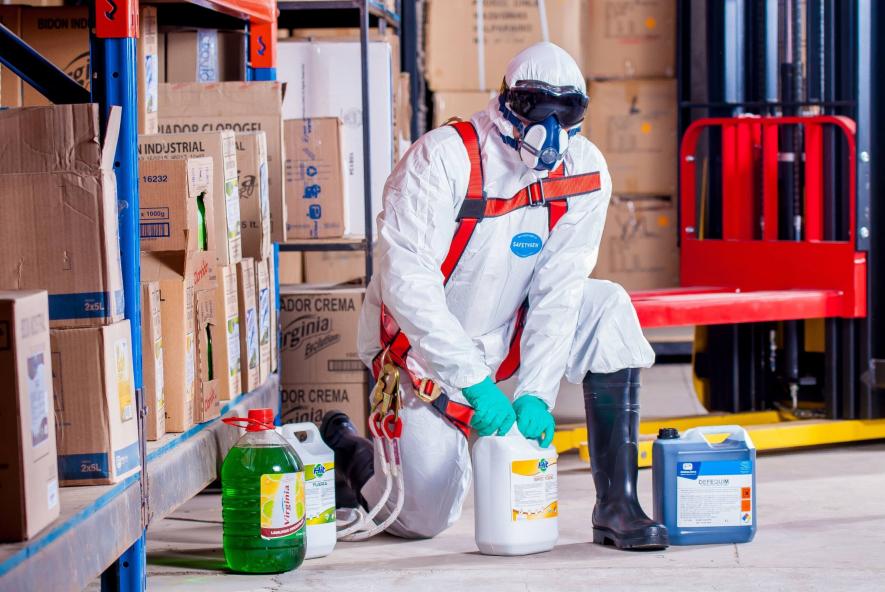Global Trade of Hazardous Chemicals Continues Despite Rotterdam Convention: Study

Representational Image. Image Courtesy: Pix4free
A new study published in Nature Sustainability suggests that large-scale global trade of hazardous chemicals continues along with illegal trades. It suggests that during 2004-2019, about 26 megatons of such chemicals were traded globally, along with those traded illegally. This, worryingly, is the situation even after a UN treaty particularly meant for limiting the global use of hazardous chemicals.
Hazardous chemicals are a threat to human health and the environment, and there has been a growing concern about limiting their use. Take, for example, lead exposure and occupational exposure to carcinogens which have caused millions of premature deaths and disability-adjusted life years (DALY).
The DALY, as defined by the WHO (World Health Organisation) is years of life lost due to disability or full health or premature mortality. Moreover, pollution due to chemicals is now turning out to be a major factor in biodiversity loss.
To limit the use of hazardous chemicals, a UN treaty was signed, known as the ‘Rotterdam Convention’, which covers 54 such chemical substances. These include mercury compounds, pesticides of various kinds and some types of asbestos. The Rotterdam Convention has been in place since 2004. It was meant for restricting the use of the listed chemicals among the signatories. However, the Rotterdam Convention does not put a full ban on these chemical substances; rather, it creates provisions for transparency in global trade.
The convention is known for its PIC (Prior Informed Consent) provision, which pertains to all the states under it publicly displaying the list of chemicals that they don’t want to import any more. This is circulated among all the states under the convention, and no countries can import the chemicals to the concerned country. It is considered illegal under international law to transport the chemicals to a country which has listed them as not-to-be-imported. However, a participating country in the convention has the right to choose which chemicals they want to import. The convention does not have any enforcement mechanism.
A recent Nature study finds that about half of the chemicals traded cross international borders illegally, which indicates the further need for intensified international measures. The study researchers from China and Switzerland analysed public trade data available in the ‘Comtrade Database’ (maintained by the UN) for 46 out of the 54 hazardous chemicals listed in the Rotterdam Convention’s annexure III. Their analysis revealed that a total of 64.5 million tons of the chemicals were traded between 2004-2019. Out of this, 27.5 million tons were traded illegally. The illegal trades mean exporting these chemicals to those countries that have refused to import them.
The study found that the non-compliance of the convention was from countries in Europe, South and Southeast Asia. Importantly, these countries have also been the most affected by the illegal trading of chemical substances. Moreover, illegal trading also encompassed the Middle East, North America and Latin America.
In a comment about the study findings, Empa (Swiss Federal Laboratories for Materials Science and Technology, St. Gallen, Switzerland) scientist Zhanyun Wang, who is also the corresponding author of the study, said—“This prevalent illegal trade is highly concerning because it undermines global efforts to protect us and our environment from hazardous chemicals.”
The study findings suggest that the overwhelming portion of the global trade of hazardous chemicals that were studied is ethylene dichloride. Around 55.3 million tons of it were traded. This chemical is a carcinogen and organ-damaging solvent and is used in PVC (Polyvinyl Chloride). The second position of the traded chemicals was taken by ethylene dioxide, which is a toxic substance used as a disinfectant and pesticide.
“We see that these highly toxic compounds are still being traded in significant quantities. Since the Rotterdam Convention came into force, trade has decreased only slightly. Yet for many of these substances, we've known for decades how harmful they are,”—Wang commented in Anna Ettlin’s article in Phys.org about the findings.
The study authors also revealed an active trade of some of the chemical substances that have been restricted or banned for decades, which include toxic pesticides Aldrin, chlordane, heptachlor, dieldrin, etc. Moreover, the study found the neurotoxic substances tetraethyl and tetramethyl lead are still traded. Notably, global efforts have been put to phase out the substances, especially from their use in gasoline. But, they seem to be still in use in some kinds of special fuels.
Get the latest reports & analysis with people's perspective on Protests, movements & deep analytical videos, discussions of the current affairs in your Telegram app. Subscribe to NewsClick's Telegram channel & get Real-Time updates on stories, as they get published on our website.















